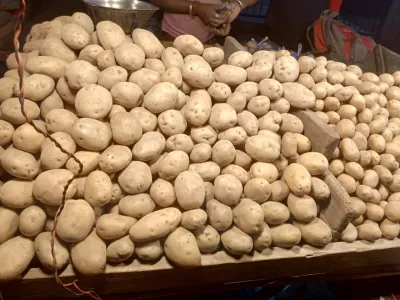Is Gujarat Leading the Charge in Processed Potato Production?

Synopsis
Key Takeaways
- Gujarat has become the leading state in processed potato production.
- It tops the export of French fries and wafers.
- Over 25% of total potato production is processed.
- Major contributing districts include Banaskantha, Sabarkantha, and Aravalli.
- Government initiatives have significantly boosted production and cultivation area.
Ahmedabad, July 14 (NationPress) In a significant milestone, Gujarat has established itself as the front-runner in the processed potatoes sector, outpacing other states in production and setting new standards for the nation’s export of processed potatoes.
Today, Gujarat stands as the top producer of processed potatoes and has also taken the lead in exporting French fries and wafers. Uttar Pradesh and Punjab occupy the second and third positions, respectively, in processed potato output.
It’s worth noting that French Fries are a beloved snack globally, enjoyed by both children and adults. With the surge in processed potato production, the nation is transitioning from being a French fries importer to an exporter.
The French fries are derived from processed potatoes, and the increase in production has significantly boosted its share within the fries and wafers market.
Gujarat is at the forefront of the nation’s processed potato export scene, producing over 11.50 lakh tonnes within the state.
Back in 2004-05, processed potato production was below 1 lakh tonnes, covering just around 4000 hectares. Thanks to state government initiatives, production has surged to 11.50 lakh tonnes, with the cultivation area expanding tenfold to approximately 37,000 hectares over the last twenty years.
In the year 2024-25, Gujarat produced 48.59 lakh tonnes of potatoes, with over 25 percent being processed varieties, while the remainder consists of Kufri potatoes used for vegetables.
The processing-grade potatoes grown by farmers in Gujarat are supplied in large volumes to processed food manufacturers producing French fries, chips, and frozen foods.
Of the total processed potato output, approximately 60 percent is allocated for wafer production and 40 percent for French fries. The major contributors include the districts of Banaskantha, Sabarkantha, and Aravalli.
During the 2024-25 season, potatoes were cultivated over a combined area of 1.19 lakh hectares in Banaskantha, Sabarkantha, and Aravalli, yielding a total of 38 lakh tonnes with an average productivity of 32.36 tonnes per hectare.









